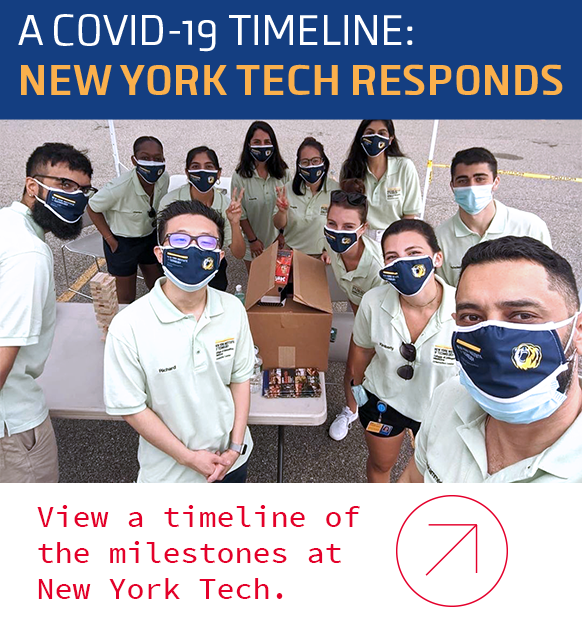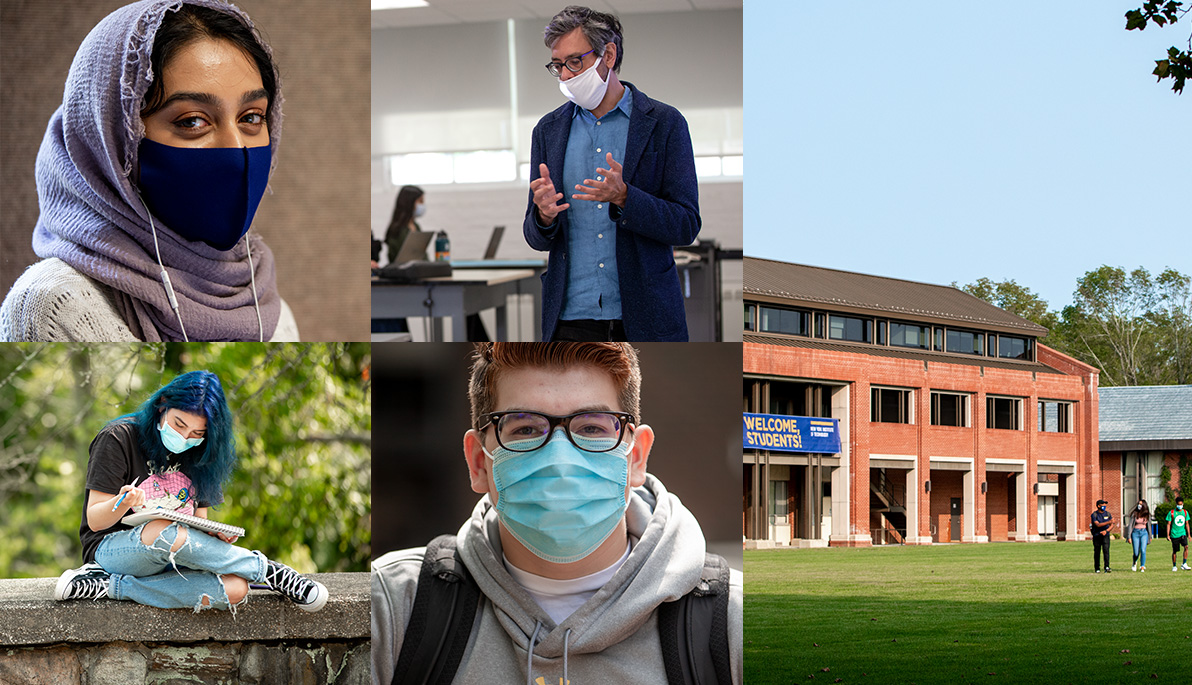
Road to Return to Campus
November 30, 2020
When the COVID-19 pandemic forced classes to remote instruction, New York Tech spent the next few months preparing to ensure a safe and successful start to the fall semester. On September 9, almost six months to the day they moved to remote learning, classes resumed, with a focus on keeping the community’s health and safety a priority and providing a quality educational experience, whether in person or remote. // Photographs by Bob Handelman
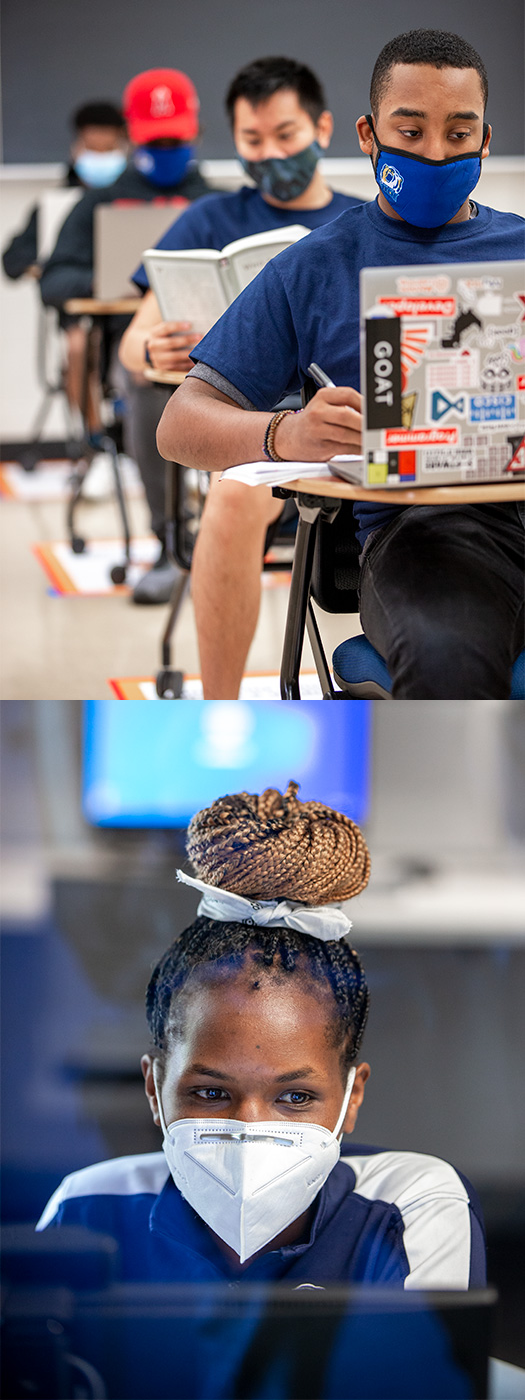
New York Tech students work from socially-distanced desks at the Long Island Campus.
Almost six months to the day that New York Tech moved to virtual instruction for the remainder of the spring semester, the university reopened its campuses in New York City and Long Island for the start of the fall semester. While medical students returned to campus to begin their academic year in early August, the official start of the fall semester on September 9 for undergraduate and graduate students was the result of months of preparations to ensure a safe and successful start, regardless of whether students would be studying on campus, virtually, or a blend of both. New York Institute of Technology President Hank Foley, Ph.D., kept the community up to date on plans and developments relating to COVID-19 via frequent emails throughout the spring and summer, noting that the university’s overarching goal would “reflect our commitment to ensuring the health and safety of the university community while fulfilling our mission of providing the highest-quality educational experience for our students.”
Supplementing his communiqués were regular emails from Chief Medical Officer and Academic Health Care Centers Director Brian Harper, M.D., regarding COVID-19 and precautionary measures for the entire community and from Provost and Vice President for Academic Affairs Junius Gonzales, M.D., M.B.A., to faculty members, offering important updates, guidance, and resources for virtual teaching and learning.
And as 1,500 class sections successfully pivoted to a virtual learning environment during the spring, an executive committee—including Harper; Suzanne Musho, chief architect and vice president for capital planning and facilities management; and Jerry Balentine, D.O., dean of NYIT College of Osteopathic Medicine and vice president for health sciences and medical affairs—was formed to develop plans to respond to local, state, and national guidelines for a safe reopening. The reopening plans (one for New York City and one for Long Island) addressed the short-term challenges of bringing students and educators back to the campuses this fall while taking the opportunity to forge university partnerships and address longer-term issues like sustainability, pedagogical practices, and university operations. New York Tech’s road to reopening included many faces and phases.
LEADing the Charge on Campus
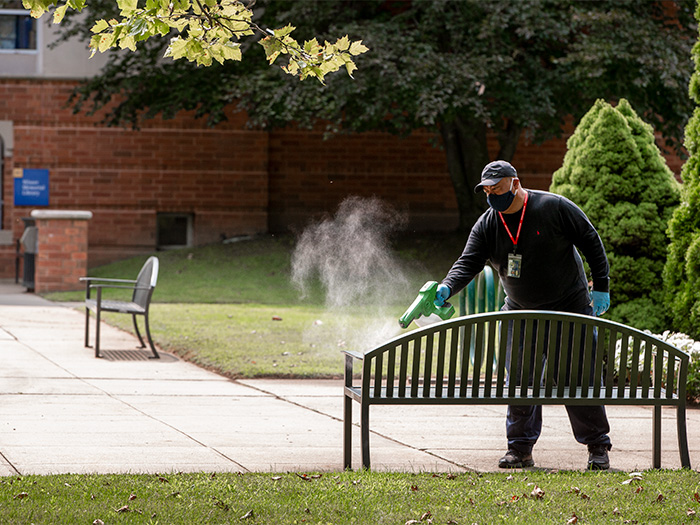
You could say that having two New York campuses that required distinctive reopening plans provided Musho and her team “double the fun.”
“We’re preparing for the future at a time when the present is extremely present,” says Musho. “The question we keep asking is, ‘What can we be?’”
The present necessitated addressing facilities via Musho’s four-point LEAD strategy, which included an integrated emphasis on health and communication:
Layout requirements for campus entry, which includes an online health screen (coordinated with developers in the Office of Information Technology) as well as the physical layout of indoor and outdoor space to ensure physical distancing.
Equipment adjustments such as hands-free operations in restrooms and mechanics for air quality and filtration.
Academic considerations to support a blended educational environment.
Disinfection strategies including sprays, UV light, and electrostatic cleaners.
In retrospect, she observes that the pandemic has crystalized humanity’s reliance on the natural environment for physical, emotional, and mental health. “At both campus locations, we’re doing anything we can to help people be outdoors.”
Campus maps highlight new outdoor and indoor spaces for studying, meeting a friend, or attending classes online and indicate check-in points where anyone entering campus must show their health screen and required face coverings. Colorful “Bear Care” signs remind community members of policies, best practices, and safety precautions to #ProtectTheDen.
At the Long Island campus, students now enjoy safely distanced spaces that include outdoor “pop-up parklets” with planters, seating, tables, and umbrellas for shade. Expanded WiFi and portable A/V units offer faculty the option of holding classes outside. And while dining options are limited to two locations this fall, a food truck will soon roll on to campus for grab-and-go service.
Options for outdoor gatherings and dining on the New York City campus provided more of a challenge, but the proximity to Central Park allows space for studying and gathering and there are countless dining options nearby. Musho and her team also needed to use different approaches because of the vertical nature of that campus, including multistory buildings that required the use of elevators and a different approach to ventilation and accessibility.
Leveraging a Legacy in Teaching With Technology
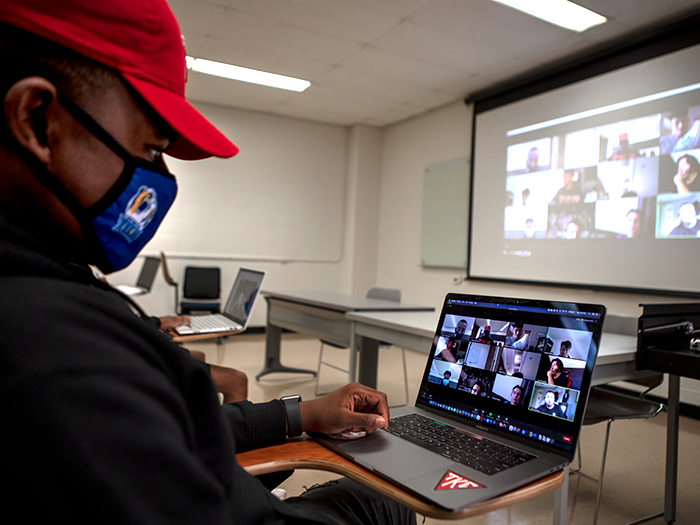
While New York Tech’s expertise and experience in teaching with technology gave the university an edge in pivoting to the remote learning environment, some heavy lifting was necessary to quickly provide technology support and resources to faculty and students, including training and supplemental software. The Center for Teaching and Learning mobilized efforts to offer workshops and training, along with online resources, and worked with faculty to create a series of videos that shared successful practices. Meanwhile, the Technology-Based Learning Systems (TBLS) provided additional support via myriad teaching activities, including the “I Wish I Could” workshops.
“We, as so many other institutions of higher education, were successful in transitioning more than 1,500 sections into remote teaching and can now highlight many successes, lessons learned, and some cautionary reflections,” notes Gonzales, who also shared results from a survey answered by nearly 2,000 students. This allowed the university to better understand the impact of the pandemic on students’ lives and learn what they value in instruction going forward. An unexpected bonus: 60 pages’ worth of comments praising individual faculty members’ efforts during the spring semester.
Over the summer, new and improved technology was added to benefit students and faculty. In early June, New York Tech transitioned its learning management systems to the industry-leading platform, Canvas. And in July, the offices of Academic Affairs and Information Technology announced the establishment of Academic Technology Services (ATS) “to support the strategic use of technologies and make significant, coordinated investments in the digital tools and resources needed to enhance teaching, learning, research, and scholarship,” according to Gonzales.
Students First
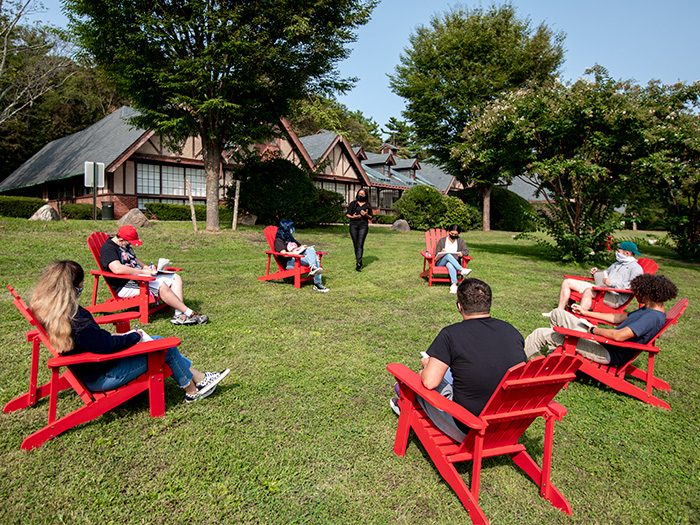
At the core of every plan and initiative was to underscore the university’s ongoing commitment to its students. And, at the core of that, were support services, engagement activities, and new resources to provide students the tools for success. In the spring, the university launched the Student Emergency Fund to assist students impacted financially by unforeseen circumstances during a disaster or crisis as well as a comprehensive set of resources and information on the website including an online “question box” to address specific issues, telehealth medical and counseling services, and supplemental online programming, advisement, forums, and more.
The Office of Student Life activated a robust online orientation program featuring interactive and multimedia content, which proved to be a hit with incoming students and boasted a 94 percent completion rate. The aptly named Students First webinar series kept new and current students informed of what to expect in the fall. And at the onset of the new semester, a tradition was born: New Student Academic Convocation, which introduced incoming students to key university leaders and programs as well as current students and alumni.
Focusing on Reinventing the Future
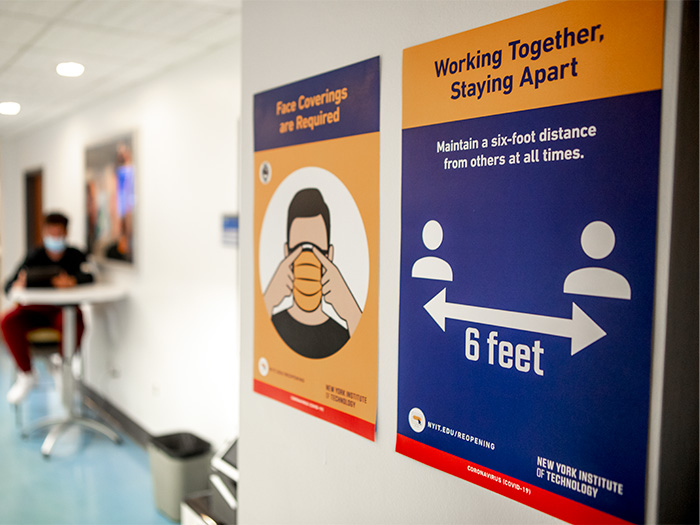
Musho notes how many of the changes being made align with longer-term university strategic plans. One sustainability initiative currently under way relates to the 300,000-gallon wastewater treatment plant on the Long Island campus. Built in 1963 and updated in 1996, the plant treats the majority of the campus’s sanitary water. The future expansion of the plant will allow the university to re-use water for irrigation, among other things, representing a huge step forward in water conservation, while also providing curricular offerings and research opportunities.
“In the big picture, we’re interested in decreasing our use of fossil fuels, using less artificial lighting, increasing our use of solar energy, and engaging more in the outdoors,” she explains.
This article originally appeared in the Fall 2020 issue of New York Institute of Technology Magazine.
More Features

An Alumnus’ Commitment to the Environment
As an energy management graduate from New York Tech’s Vancouver campus, Jasdeep Gulati (M.S. ’22) is highly invested in educating people about environmental and climate sustainability.

Vancouver Faculty Win University-Sponsored Research Awards in New Program
The new Global Impact Research Grant (GIRG) program has been developed to keep Vancouver-based faculty connected to faculty and research projects being conducted on the university’s New York campuses.

Studying Climate Change One Degree at a Time
Junhua Qu (M.S. ’24) began her collegiate journey in Beijing. But, her interest in climate change took her to New York Tech’s Vancouver campus to study energy management.
